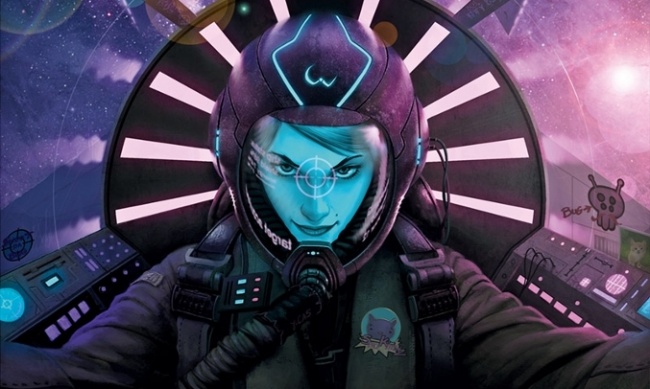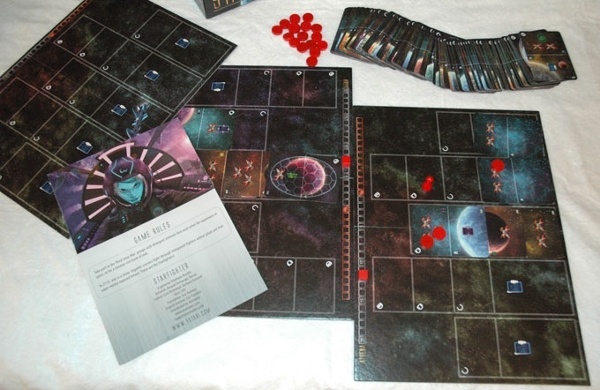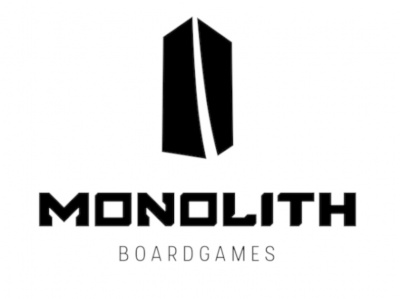Starfighter
Publisher: Ystari Games (Distributed by Asmodee)
Release Date: August 2015 (US)
Price: $29.99
Designer: Stephane Boudin
Artwork: Arnaud Demaegd, Neriac
Format: Board game w/ cards and game tokens
Product #: STA01
Players: 2
Playing Time: 30 minutes
Ages: 13 and up
ICv2 Rating: 4 Stars out of 5
Who doesn’t get excited about space combat? It’s the mainstay of sci-fi cinema, and the stuff of childhood dreams: the intensity of fighters weaving in and out between explosions, dodging laser beams, and blowing the enemy starships into tiny pieces. You would expect a card game about space fighter combat to be an intense nail-biting affair, with rapid-fire gameplay and edge of your seat tension, right? Well, at least in the case of Ystari’s Starfighter, you’d be wrong. This is, instead, a clever game of careful planning and deep strategy, where Fortune favors not so much the bold, as the canny tactician.
Summary: Two cruisers, naturally named for Greek gods, confront each other in deep space. Apparently unarmed themselves, they rely on great squadrons of starfighters, deployed into the killing field between them. The fighters must blast their way through the waves of enemy fighters to clear a path to the enemy cruiser. The first squadron that can force the enemy to withdraw (by inflicting enough damage to the enemy cruiser) wins the battle.
The actions of the starfighters is controlled through the use of cleverly designed double sided action cards. But in order to make best use of your assets, you must arrange your cards to gain the maximum benefit of carefully timed actions: every time a card in a stack is revealed, the entire battlefield can shift as cards are moved, reordered, flipped, or turned, changing the abilities of a squadron dramatically.
Three different "gameplay modes" are included: a stripped down introductory "Initiation," a more complete "Skirmish," and for those who like to “build their own deck," the "Total War" version where players build and draw cards from their own deck instead of a central common one, allowing for greater strategic control of your options during the game.
Originality: Okay, so the theme of starfighters blasting it out in space is just about as old as science fiction itself, so no points there. But ignoring that, the game mechanics are really quite innovative. Each action card is double sided, and either side can be used when the card is played. Each face is further divided into a top and bottom half, and the orientation of the card has a significant impact on what that card does when firefights are resolved. A variety of actions are possible, from shifting cards into other battle sectors, changing the sequence of cards, or even flipping or rotating them to completely alter their effects. While a bit challenging to learn, the wealth of tactical options this system opens up is quite broad.
Also particularly clever is the games built in "catch-up" mechanic. Your ability to draw cards is automatically reduced the more cards you put into play—at least until those cards are destroyed by your opponent’s starfighters. But, in order to attack your opponent’s cruiser, you need to have cards in play--and typically more cards in play than your opponent can muster. Furthermore, each time a card in a stack is revealed, by the destruction of the card above it for example, the card’s owner gets to take the action shown. So, every time you attack, you increase your opponent’s ability to take actions and draw cards, increasing their tactical options, even as you restrict your own.
Presentation: The artwork is a bit dark, with a somewhat limited palette of colors, but the slightly cartoonish style works nicely. The box cover could have been brighter and more attention-grabbing, but the game title is easy enough to read and the imagery is evocative of the game theme. Sadly, the box back doesn’t do much to describe what the game is about, but considering the limitations of the box size, there wasn’t much that could be done there.
The game was clearly intended for international production, as all of the game effects are represented by ions that, while clear enough to an experienced player, are a bit confusing at first. This problem could have been resolved nicely if there had been a couple player aids included, instead of relying on the back cover of the rulebook for a chart of icon effects alone. Otherwise, the game graphics are clear and easy to use.
Quality: Starfighter was produced to the European standards of quality that we have come to expect: the three game boards are good heavy stock, the cards are thick with a linen finish, the game markers are all nice wooden tokens and cubes. The box is sturdy and includes a functional cardboard insert, though in fairness it could have been half the size and still held more than all the components inside. The game rules are clearly written and well-illustrated, and no glaring translation errors were in evidence.
Marketability: The price asked is quite reasonable for what’s inside the box, and the game theme is accessible to a broad audience while not being bogged down with any particularly IP license. The rules are easy to learn, and most players will have the game mechanics figured out after a few turns, yet the strategic depth offers a lot of replayability, especially with the deck construction options of the “Total War” version.
Overall: Appearances can be deceiving, as quickly becomes apparent when approaching Starfighter for the first time. The compact box, the card-based gameplay, and the shoot-em-up theme all imply a lightweight quick filler game. But instead, you get something of a brain-burner. Success in the game requires careful planning, as the sequence in which cards are resolved can have a huge impact on the results of each firefight. And since there are plenty of ways to mess with your opponent’s carefully-laid plans, every play must be deeply considered, and like chess you need to be thinking three moves ahead. The result is a richly rewarding game of intense tactics and strategy with a lot of replayability.
There are flaws though, which keeps this game from scoring higher. The lack of player aids is one, the curious decision to include only four different cruisers on the three double sided boards instead of six, and the lack of a really equitable way to divide the cards between two players when playing the Total War version are all issues that could have been handled better. Despite those problems, I can comfortably give Starfighter 4 out of 5.
--William Niebling

ICv2 Stars: 4 (out of 5)
Posted by William Niebling on September 30, 2015 @ 1:26 am CT
MORE GAMES
Based on Video Game
April 23, 2024
Games Workshop will release Warhammer 40,000 Darktide: The Miniatures Game, based on the video game released for Xbox last year.
In Court Ruling
April 23, 2024
Monolith Board Games has acquired assets of the defunct Rackham Company, which were assigned by the Paris Commercial Court.
MORE REVIEWS
ICv2 Stars: 3.5 (out of 5)
February 23, 2024
Here's a review of The Lucy Poor graphic novel, published by Iron Circus.
ICv2 Stars: 4 (out of 5)
February 20, 2024
Here's a review of Nina Simone in Comics, published by NBM Publishing.









